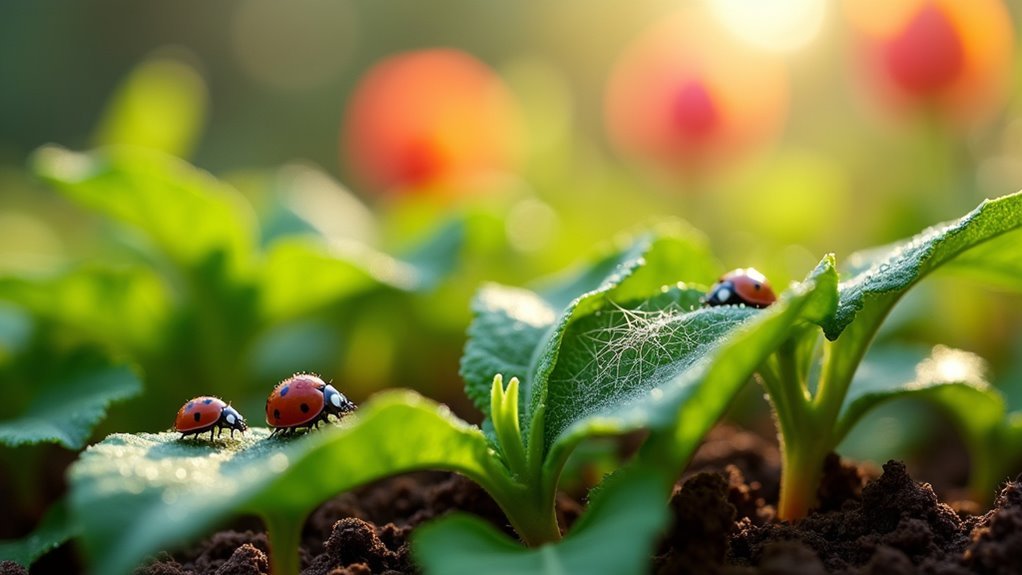Following nature’s rhythm for pest management creates a self-regulating garden ecosystem where you work with natural cycles instead of against them. You’ll align your pest control strategies with phenological patterns, timing interventions when beneficial insects are most active and pests are vulnerable. This approach reduces chemical dependency while building resilient populations of natural predators. By observing seasonal patterns and lunar phases, you’ll anticipate pest emergence and strengthen your garden’s natural defenses throughout the year.
Understanding Phenological Cycles in Garden Ecosystems

Have you ever wondered why certain garden pests seem to appear like clockwork each season?
You’re witnessing phenological cycles in action. These natural rhythms track the timing of biological events, from plant blooming to insect emergence, creating predictable patterns within garden ecosystems.
Understanding these cycles transforms your pest management approach. By observing nature’s schedule, you’ll anticipate pest life stages before they become problematic.
Timing is everything in pest control—predict their arrival by watching nature’s calendar, not your own.
Temperature changes accelerate or delay these cycles, so you can adjust your timing accordingly. This knowledge forms the foundation of effective Integrated Pest Management (IPM) strategies.
When you align your gardening practices with these natural patterns, you create a harmonious relationship between human intervention and ecosystem balance, making pest control more efficient and environmentally sustainable.
Spring Awakening: Early Season Pest Prevention Strategies
Spring’s arrival brings both opportunity and challenge as dormant pests stir to life with rising temperatures. You’ll need proactive pest management strategies to stay ahead of emerging threats.
Start with early season pest scouting through weekly inspections, watching for aphid damage on leaves or sawfly larvae evidence. Install physical barriers like row covers over vulnerable seedlings—they’ll block pests while allowing essential sunlight and moisture through.
When soil temperatures hit 50°F, release beneficial nematodes to target soil-dwelling pests naturally.
You can enhance your garden’s defenses by selecting pest-resistant varieties and incorporating companion planting techniques. This integrated approach combines multiple pest control methods, creating a resilient ecosystem where beneficial insects thrive.
Summer Vigilance: Peak Growing Season Natural Defenses

You’ll need to ramp up your pest monitoring efforts as summer’s heat and extended daylight create perfect conditions for both plant growth and pest explosions.
Installing physical barriers like row covers and strategically placing companion plants becomes essential for protecting your vulnerable crops during this intense growing period.
Focus on attracting beneficial insects through targeted plantings and habitat creation, as these natural allies will become your most valuable defense force against the summer pest surge.
Peak Pest Activity Monitoring
As temperatures climb and garden growth accelerates, pest populations surge to their annual peak, demanding your most vigilant monitoring efforts.
You’ll need to scout regularly for aphids, Japanese beetles, and other common invaders that become most active during late spring through early summer. Implementing integrated pest management (IPM) strategies becomes vital now—use traps and monitoring tools to track populations and assess damage levels accurately.
Don’t overlook the beneficial insects working alongside you. Ladybugs, lacewings, and other natural allies often appear during peak activity periods, providing essential natural pest control.
Encourage these helpers through strategic habitat planting. By adapting your strategies to pest life cycles and timing interventions precisely, you’ll minimize damage while maintaining ecological balance throughout this essential growing season.
Natural Barrier Implementation Strategies
While monitoring gives you the intelligence needed to identify threats, physical barriers provide your garden’s front-line defense against invading pests during summer’s most vulnerable growing period.
Install row covers and insect netting before anticipated pest outbreaks, timing deployment using phenological observations for maximum effectiveness. These natural defenses allow sunlight and moisture penetration while blocking harmful insects.
Regularly inspect and maintain your physical barriers to prevent pest infiltration through tears or gaps.
Combine barriers with companion planting strategies—certain plants emit scents that repel pests while attracting beneficial pollinators. Integrate organic repellents and beneficial insects alongside your barrier system to create a multifaceted defense approach.
This all-encompassing strategy strengthens plant protection while maintaining ecological balance in your garden ecosystem.
Beneficial Insect Recruitment Methods
Beyond physical barriers, recruiting beneficial insects transforms your garden into a self-regulating ecosystem where nature’s predators handle pest control duties.
Plant diverse flowering plants like sunflowers and marigolds that attract beneficial insects such as ladybugs and lacewings to naturally control pest populations. Create designated insectary strips within your garden to provide essential habitats for pollinators and predatory species, boosting overall biodiversity.
Time your beneficial insect introductions strategically—release parasitic wasps when pest populations rise for maximum impact.
Maintain consistent nectar and pollen sources throughout summer to keep these natural allies active in your space. This organic gardening approach creates a harmonious ecosystem where effective pest management occurs naturally.
Monitor beneficial insect activity regularly to make informed decisions about your garden’s natural defense strategies.
Fall Preparation: Disrupting Pest Overwintering Cycles

When temperatures drop and daylight hours shorten, many garden pests begin their search for cozy overwintering spots—and your garden debris provides the perfect shelter.
As autumn arrives, garden pests actively seek warm hiding places in your yard’s fallen leaves and plant debris.
Effective fall preparation starts with thorough cleanup, removing fallen leaves and plant residue that harbor overwintering cycles. You’ll disrupt pest populations considerably by implementing crop rotation, which eliminates their preferred food sources and breeding grounds.
Install physical barriers like row covers to prevent late-season egg-laying while protecting vulnerable crops. Plant cover crops to enrich soil and create habitat for beneficial insects that prey on overwintering pests.
Monitor pest populations regularly so you can introduce beneficial nematodes targeting soil-dwelling species. These integrated pest management strategies work together, using nature’s seasonal changes to break destructive cycles before spring arrives.
Winter Planning: Setting the Stage for Next Year’s Success
As winter settles over your garden, this quiet season becomes your strategic planning headquarters for next year’s pest management success. Your winter planning sets the foundation for proactive management strategies that’ll protect your crops before pests even emerge.
Start by conducting thorough assessments of last season’s pest pressure areas. Clean up garden debris to eliminate overwintering habitats, then develop your crop rotation plan to disrupt pest cycles.
| Winter Planning Task | Garden Benefit |
|---|---|
| Soil testing | Identifies nutrient deficiencies |
| Debris cleanup | Removes pest habitats |
| Crop rotation planning | Disrupts pest cycles |
| Physical barriers prep | Guarantees early protection |
Use these months for soil testing to enhance plant health and resilience. Plan physical barriers like row covers so they’re ready when spring arrives, creating your resilient garden foundation.
Lunar and Seasonal Timing for Optimal Pest Control
Nature’s celestial rhythms offer gardeners a powerful advantage in timing pest control strategies for maximum effectiveness.
You’ll find that lunar cycles considerably influence pest behavior, with many insects showing increased activity during specific moon phases. During the waxing moon, you should focus on planting and pest management activities, as plants display greater vigor while pests remain less active.
Seasonal changes dictate pest life cycles, requiring you to adapt your monitoring strategies accordingly.
Time your natural deterrents and beneficial insects releases to coincide with seasonal peaks in pest emergence. This alignment greatly enhances your pest management effectiveness.
Building Beneficial Insect Populations Through Natural Rhythms
You can transform your garden into a thriving ecosystem by aligning your planting schedule with the natural life cycles of beneficial insects like ladybugs and lacewings.
Understanding when these pest-fighting allies emerge and reproduce allows you to time your flower plantings perfectly, ensuring they’ll have abundant food sources exactly when they need them most.
Creating these natural habitat sanctuaries requires strategic companion planting and maintaining diverse plant species that bloom throughout the growing season, giving beneficial insects continuous support while they control harmful pests in your garden.
Seasonal Beneficial Insect Cycles
When you align your pest management practices with the natural cycles of beneficial insects, you’ll create a self-sustaining defense system that works year-round. Understanding seasonal cycles of ladybugs, lacewings, and other beneficial insects allows you to time habitat creation perfectly with their emergence periods.
During early spring, plant flowering species that provide essential resources for overwintering predators, ensuring robust populations when pest pressure increases.
Companion planting becomes strategic when you synchronize it with beneficial insects’ life cycles that align with specific plant blooms. This timing maximizes biological control effectiveness while fostering a balanced ecosystem.
Monitor both pest and natural enemy cycles to implement timely interventions. You’ll reduce chemical dependency while creating habitat that supports these natural defenders throughout their seasonal changes, establishing sustainable pest management.
Creating Natural Habitat Sanctuaries
Building diverse habitat sanctuaries transforms your garden into a thriving ecosystem where beneficial insects can establish permanent colonies. Your natural habitat becomes a fortress against pests when you strategically design spaces that support year-round insect populations.
Essential elements for creating effective sanctuaries include:
- Diverse plantings – Establish native wildflowers and herbs that bloom throughout growing seasons, ensuring continuous food sources for beneficial insects while building healthy soil foundations.
- Undisturbed zones – Maintain brush piles and native grass strips where beneficial insect larvae can develop without disturbance, strengthening your ecosystem’s natural pest control capabilities.
- Companion planting strategies – Integrate pest-repellent plants alongside susceptible crops, creating symbiotic relationships that naturally deter harmful insects while supporting seasonal diversity.
These sanctuary elements work together, fostering resilient beneficial insect populations that’ll protect your garden naturally.
Creating Year-Round Habitat Balance for Sustainable Pest Management
As nature follows predictable cycles throughout the seasons, your garden’s pest management strategy should mirror these rhythms to create lasting habitat balance.
You’ll achieve year-round habitat balance by implementing companion planting and intercropping techniques that support beneficial insects throughout changing seasons. Plant cover crops in fall to enhance soil health while providing overwintering sites for pest predators.
Create wildlife corridors and pollinator gardens that sustain biodiversity across all seasons.
Monitor pest populations regularly to inform your seasonal strategies, adjusting interventions as conditions change. Use physical barriers like row covers during vulnerable spring periods while maintaining ecological balance.
Frequently Asked Questions
What Is the Most Effective Pest Management Why?
You’ll find IPM most effective because it combines multiple strategies like biological controls, monitoring, and targeted treatments. It reduces chemical dependence while maintaining beneficial insects, creating sustainable pest control that adapts to your garden’s ecosystem.
Why Is Pest Management Important?
You’ll protect your crops from devastating yield losses that can exceed 50% while preserving beneficial insects, reducing chemical dependency, and maintaining a healthy garden ecosystem that naturally controls pest populations.
What Are the Four Principles of Integrated Pest Management?
You’ll implement four key principles: monitor pest populations regularly, establish action thresholds that trigger interventions, combine multiple control methods including cultural and biological approaches, and evaluate your management strategies’ effectiveness for continuous improvement.
What Is the Meaning of Natural Pest Management?
You’ll use ecological principles and biological processes to control pests without synthetic chemicals. You’re combining monitoring, cultural controls, natural predators, and companion planting to maintain balanced ecosystems while effectively managing pest populations.
In Summary
You’ll discover that working with nature’s rhythm isn’t just effective—it’s transformative for your garden’s health. When you align your pest management with seasonal cycles, you’re creating a self-sustaining ecosystem that works for you year-round. You won’t need harsh chemicals or constant intervention. Instead, you’ll build resilient beneficial populations and natural defenses. Trust nature’s timing, and you’ll find pest management becomes less work and more collaboration with the environment around you.





Leave a Reply